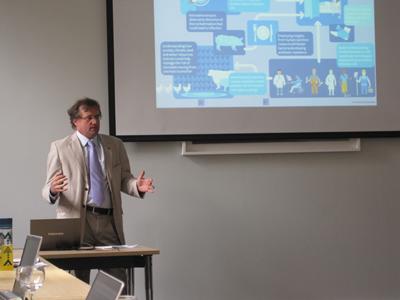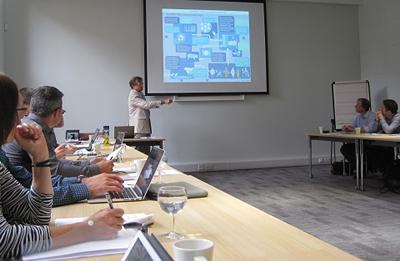Second 'All-Networks' AMR meeting hosted by SHAMROK at Sheffield hears EPSRC on future funding for AMR

NAMRIP Chair, Professor Tim Leighton and Programme Manager on the EPSRC 'NAMRA' grant, Yvonne Richardson attended the second All-Networks meeting of the eleven EPSRC- NAMRA ‘Bridging the Gaps’ funded Universities which was hosted this year by the SHAMROK network at Sheffield.

Each of the EPSRC funded Universities set up a network of researchers whose work, in responding to the challenges posed by antimicrobial resistance, bridges the gap between Engineering and Physical Sciences (EPS) and Non-Engineering and Physical Sciences (non-EPS) research. The first of these meetings was initiated by NAMRIP at Southampton on 25 August 2015. It provided an opportunity for the networks to share plans and approaches, and the symposium was followed by dinner at the last surviving remnant of Florence Nightingale's military hospital at Netley. The outcome of that meeting was a decision to meet again and report progress after a year. In the meanwhile, each network has shared news of its activities with the other Universities in the group and many delegates have visited each other's networks.
The second meeting
The second meeting of the consortium was hosted by the SHAMROK network at Sheffield University in the Council Room, Firth Court. Principal Investigators from each of the eleven Universities in the group gave presentions on their progress to date. Christina Turner and Stephanie Newland from EPSRC gave a presentation that explained the funding environment for networks and science. The presentation is available below.

The group then divided, with principal investigators meeting in one room and grant programme managers in another. The discussions centred on holding a possible joint final conference and on the options open for securing follow-on funding to ensure that the networks do not dry up. In the PI discussion, Professor Leighton pointed out that we are still in the exploration phase for looking for solutions to AMR, and so it is unhelpful to expect that at the cessation of these networks the effort could be replaced by large project grants, because that represents crystallising the 'soup' of solutions into a few well funded options, which might have the effect of closing off the ingenuity that would have existed had that 'soup', and those networking activities, been maintained.
The Programme Managers group discussed best practice generally, particularly in the area of sharing network achievements. There is a lot to share and each network has a plethora of activities, among them sandpit events, conferences and pump-priming projects. The marketing of these formed a lively discussion on its own. The group shared best methods of using social media and newsletters and also touched on what might be the the benefits of joint activities between networks as a way to increase engagement.
Delegates had a further opportunity to network and exchange ideas over lunch before the meeting closed.